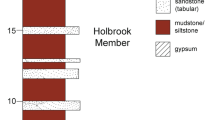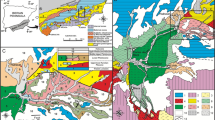Abstract
Studies were carried out in the upper reaches of the Akkem River aimed at explaining why the local ungulates consume clay rocks common in the basin of the Yarlu River, a tributary of the Akkem River. Chemical composition of river and spring waters and mineral and chemical composition of clay rocks consumed by wild and domestic ungulates at kudurs were studied. The waters in the local watercourses are ultra-fresh, hydro-carbonate-calcium. Increased concentrations of rare-earth elements (REE) were observed in waters of the Yarlu River. Consumed clayey rocks (kudurits) are represented by finely dispersed quartz-plagioclase-mica-chlorite mineral associations — the products of transformation of shale rocks of the Early Paleozoic age. The comparison of the chemical composition of kudurits and coprolites of red deer showed that when the rocks pass through the digestive tract, out of all macroelements, only Na is reliably assimilated in the body in amounts from 0.1 to 0.3 g per kg of kudurit. In addition, kudurits act as sorbents, removing P, K, Mg, and sometimes Ca from the body. As part of micronutrients, they are most active in sorbing and removing REE from the body.







Similar content being viewed by others
References
Abrahams PW (1997) Geophagy (soil consumption) and iron supplementation in Uganda. Trop Med Int Helth 2(7):617–623
Anderson CR, Pederson K (2003) In situ growth of Gallionella biofilms and partitioning of lanthanides and actinides between biological material and ferric oxyhydroxides. Geobiology 1:169–178
Anell B, Lagercrantz S (1958) Gefagical customs. Stud Ethnogr Upsal 17:98p
Barmettler F, Castelberg C, Fabbri C, Brandl H (2016) Microbial mobilization of rare earth elements (REE) from mineral solids –a mini review. AIMS Microbiol 2(2):190–204
Dudeney AWL, Sbai ML (1993) Bioleaching of rare-earth-bearing phosphogypsum. In: Torma A.E., Wey J.E., Lakshmanan VL (eds.) Biohydrometallurgical Technologies. The Minerals, Metals, & Materials Society. Jackson Hole. pp. 39–47
Ekosse G-I, Chistyakov KV, Rozanov AB, Bashkirova NN, Dultz S, Polekhovsky YS, Lessovaia SN (2020) Landscape settings and mineralogy of some geophagic clay occurrences in South Africa /O. V. Frank-Kamenetskaya et al. (eds.), Processes and Phenomena on the Boundary Between Biogenic and Abiogenic Nature, Lecture Notes in Earth System Sciences, pp 785–801. https://doi.org/10.1007/978-3-030-21614-6_42
Fraser D, Reardon E (1980) Attraction of wild ungulates to mineral-rich springs in central Canada. Holarct Ecol 3:36–40
Gilardi JD, Duffey SS, Munn CA, Tell L (1999) Biochemical functions of geophagy in parrots: detoxification of dietary toxins and cytoprotective effects. J Chem Ecol 25:897–922
Houston DC, Gilardi JD, Hall AJ (2001) Soil consumption by elephants might help to minimize the toxic effects of plant secondary compounds in forest browse. Mammal. Review. Vol. 31. Is 3–4:249–254
Ketch LA, Malloch D, Mahaney WC, Huffman MA (2001) Comparative microbial analysis and clay mineralogy of soil eaten by chimpanzees (Pan troglodytes schweinfurhii) in Tanzania. Soil Biol Biochem 33(2):199–203
Krishnamani R, Mahaney WC (2002) Geophagy among primates: adaptive significance and ecological consequences. Anim Behav 59:899–915
Kreulen DA (1985) Lick use by large herbivores: a review of benefits and banes of soil consumption. Mammal Rev 15:107–123
Lavelle MJ, Phillips GE, Fischer JW et al (2014) Mineral licks: motivational factors for visitation and accompanying disease risk at communal use sites of elk and deer. Environ Geochem Health 36:1049–1061. https://doi.org/10.1007/s10653-014-9600-0
Lebedeva E, Panichev A, Kharitonova N, Kholodov A, Golokhvast К (2020) Diversity, abundance, and some characteristics of bacteria isolated from earth material consumed by wild animals at kudurs in the Sikhote-Alin Mountains, Russia // International Journal of Microbiology Volume 2020, Article ID 8811047, 9 pages https://doi.org/10.1155/2020/8811047
Mahaney WC, Watts D, Hancock RGV (1990) Geophagia by mountain gorillas (Gorilla gorilla beringei) in the Virunga Mountains Rwanda. Primates 31(1):113–120
Mills A, Milewski A (2006) Geophagy and nutrient supplementation in the Ngorongoro Conservation Area, Tanzania, with particular reference to selenium, cobalt and molybdenum. J Zool 271:110–118. https://doi.org/10.1111/j.1469-7998.2006.00241.x
Moe SR (1993) Mineral content and wildlife use of soil licks in southwestern Nepal //. Can J Zool 71:933–936
Mure AJ (1934) The Moose of Isle Royale. Misc Publ Mus Zool Univ Mich N25:1–44
Nasimovich AA (1938) In regard to the knowledge of the mineral nutrition of wild animals of Caucasian Reserve. Proceedings of the Caucasus Nature Reserve. Iss. 1. Moscow. 103–150. (in Russian)
Oates JF (1978) Water-plant and soil consumption by Guereza Monkeys (Colobus guereza): a relationship with minerals and toxins in the diet? Biotropica 10:241–253
Panichev AM (1990) Geophagia in the worlds of animals and humans. 223 p. Moscow: Nauka (in Russian)
Panichev AM (2011) Geophagy (geological, ecological and biomedical aspects). 149 p. Moscow: Nauka (in Russian)
Panichev AM, Golokhvast KS, Gulkov AN, Chekryzhov I Yu (2013) Geophagy and geology of mineral licks (kudurs): a review of russian publications. Environmental Geochemistry and Health. № 1. 133–152
Panichev AM (2015) Rare earth elements: review of medical and biological properties and their abundance in the rock materials and mineralized spring waters in the context of animal and human geophagia reasons evaluation// Achievements in the. Life Sci 9:95–103. https://doi.org/10.1016/j.als.2015.12.001
Panichev AM (2016) Geophagia: causes of the phenomenon. Priroda. No. 4. P. 25–35. (in Russian)
Panichev AM, Popov VK, Chekryzhov IYu, Seryodkin IV, Stolyarova TA, Zakusin SV et al (2016) Rare earth elements upon assessment of reasons of the geophagy in Sikhote-Alin region (Russian Federation), Africa and other world regions. Environ Geochem Health 38:1255–1270
Panichev AM, Seryodkin IV, Kalinkin YN, Makarevich RA, Stolyarova TA, Sergievich AA et al (2018) Development of the “rare-earth” hypothesis to explain the reasons of geophagy in Teletskoye Lake are kudurs (Gorny Altai, Russia). Environ Geochem Health 40:1299–1316
Panichev AM, Trepet SA, Chekryzhov IYu, Seryodkin IV, Vakh EA, Makarevich RA, Eskina TG, Bibina KV, Stolyarova TA, Mitina EI, Ivanov VV, Ostapenko DS, Kholodov AS, Golokhvast KS (2021a) A study of kudurs used by wild animals located on the water sources high in REE content in the Caucasus Nature Reserve. Environ Geochem Health 43(1):91–112. https://doi.org/10.1007/s10653-020-00670-8
Panichev AM, Baranovskaya NV, Seryodkin IV, Chekryzhov I Yu, Vakh EA, Soktoev BR, Belyanovskaya AI, Makarevich RA, Lutsenko TN, Popov N Yu, Ruslan AV, Ostapenko DS, Vetoshkina AV, Aramilev VV, Kholodov AS, Golokhvast KS (2021b) Landscape REE anomalies and the cause of geophagy in wild animals at kudurs (mineral salt licks) in the Sikhote-Alin (Primorsky Krai, Russia). Environ Geochem Health. https://doi.org/10.1007/s10653-021-01014-w
Parker KL, Ayotte JB (2004) Ecological importance of mineral licks in the Tuchodi Watershed, North-Central British Columbia. Natural Resources and Environmental Studies University of Northern British Columbia Prince George, British Columbia. https://web.unbc.ca/~parker/MKReports/FINAL%20LICK%20REPORT%20revised.pdf. Accessed 11 Dec 2021
Pebsworth PA, Huffman MA, Lambert JE, Young SL (2018) Geophagy among nonhuman primates: a systematic review of current knowledge and suggestions for future directions. American Journal of Physical Anthropology 168 Suppl 67(3). https://doi.org/10.1002/ajpa.23724
Ramachandran KK, Balagopalan M, Vijayakumaran Nayr P (1995) Use pattern and chemical characterization of the natural salt licks in Chinnar wildlife sanctuary (Research report 94). Kerala Forest Research Institute Peechi, Thrissur, 18 p. http://docs.kfri.res.in/KFRI-RR/KFRI-RR094.pdf
Redling K (2006) Rare earth elements in agriculture with emphasis on animal husbandry. dissertation, LMU München: Tierärztlichen Fakultät. https://doi.org/10.5282/edoc.5936. Availably at: https://edoc.ub.uni-muenchen.de/5936/
Sotnikov VI, Nikitina EI (1971) Molybdenum-rare-metal-tungsten (greisen) formation of the Altai Mountains, Novosibirsk, Nauka. 260 p. (in Russian)
Vermeer DE, Ferrell RE (1985) Nigerian geophagical clay: a traditional anti-diarrhoeal pharmaceutical //. Science 227:634–636
Wilson MJ (2003) Clay mineralogical and related characteristics of geophagic materials. J Chem Ecol 29(7):1525–1547
Acknowledgements
This study was financially supported by the Russian Science Foundation (projects: 20-67-47005 and 20-64-47021).
Author information
Authors and Affiliations
Corresponding author
Ethics declarations
Conflict of interest
The authors declare no competing interests.
Additional information
Responsible Editor: Domenico M. Doronzo
Rights and permissions
About this article
Cite this article
Panichev, A., Baranovskaya, N., Seryodkin, I. et al. Kudurs (mineral licks) in the Belukha Mountain area, Altai Mountains, Russia. Arab J Geosci 15, 1284 (2022). https://doi.org/10.1007/s12517-022-10478-8
Received:
Accepted:
Published:
DOI: https://doi.org/10.1007/s12517-022-10478-8





